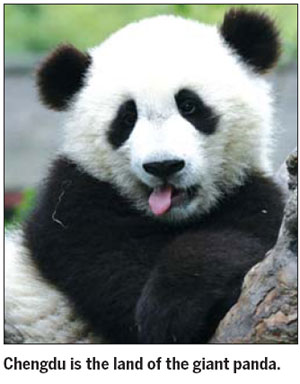

Home of giant pandas, archaeological wonders and renowned cuisine, Chengdu is a city with a wealth of tourism resources, which local leaders say are crucial to boosting the city's economy as well as gaining influence abroad.
One of China's famous historical and cultural centers, Chengdu, capital of southwest China's Sichuan province, has been recognized by the National Tourism Administration as one of the nation's best tourism destinations.
It is also the fifth Chinese observation site that the United Nations World Tourism Organization has established to promote sustainable tourism. The center gathers and reports data to measure the environmental, cultural, social and economic impacts of tourism based on the UNWTO's sustainable tourism indictors.
Of the five observation sites, Chengdu is the only urban area, and it is an important regional tourism hub for China's southwest.
Sichuan capital attracts with its ancient charm

A UNWTO official said they chose Chengdu to find ways tourism could slow the pace of life in a place where society and the economy are developing so quickly.
Moreover, Chengdu is also an ancient city that has never moved or changed its name during the past two millennia, which is a rarity among the developmental histories of cities worldwide.
Chengdu has a rich history and a profound cultural legacy. Its leisurely lifestyle and the idyllic scenery of rural areas also add to the allure of the city.
Chengdu is the land of the giant panda, a highly endangered species - fewer than 2,000 remain the world.
Some 10 kilometers from the downtown a giant panda breeding research center houses around 100 giant pandas in a free and simulated wild environment. It is a perfect place for people to observe and have close contact with the iconic animals.
The center also breeds other endangered species, such as the red panda and the black-necked crane.
The panda center may be mainly attractive to kids and animal lovers, but the city also has many historical relics to impress other visitors.
In 2001, the remains of the 3,000-year-old Jinsha civilization were dug out at the city's western suburb, which is widely believed to have been the capital of the ancient Shu state.
The site, covering an area of 5 square kilometers, has been hailed as one of the major archeological discoveries in China in the 21st century.
One of the unearthed Jinsha relics is a gold foil of the divine solar bird, which is now the symbol of Chengdu and its Chinese cultural heritage.
Other artifacts made from ivory, jade, bronze, gold and stone have also been found at the site, reflecting the mystery and glory of the ancient Shu state.
Chengdu is also home to Qingcheng Mountain and the Dujiangyan irrigation system. The mountain has long been recognized as the birthplace of Taoism, China's ancient indigenous religion, and Dujiangyan is considered to be the oldest functioning water-control project in the world.
According to the historical records, the Dujiangyan system was built in 256 BC by a local official to tame frequent flooding of the Minjiang River. It survived the disastrous Wenchuan earthquake almost unscathed in 2008.
These two tourist spots were both included on the list of UNESCO world heritage sites in 2000.
In addition, the city also has 17 national intangible cultural heritages and hosts the world's only related theme festival approved by the State Council.
Chengdu is also famous for its spicy, flavorful cuisine. It has more than 6,000 dishes, and its signature dish is Sichuan hotpot.
In 2010, Chengdu became the first city in Asia to be recognized by UNESCO as a "world capital of gourmet food".
haonan@chinadaily.com.cn
(China Daily 01/30/2013 page24)

In China, most giant pandas live in the mountains of Qinling, Minshan, Qionglai, Daxiangling and Xiaoxiangling.

By the end of 2011, the number of wild giant pandas in the world was about 1,590.